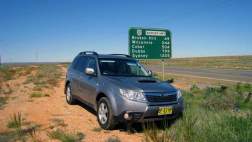And he's certainly caught more than his share. The Valiant Pacer was the performance version of the Valiant, in the days when the Australian car industry had the Big Three GM with its Holdens and Monaro, Ford with its Falcons and GT and Chrysler with its Valiants.
Mr Moularas is pictured with just one of his collection, a 1970 VG Valiant Pacer, an ex-race car. Chrysler and Valiant fans this year are celebrating the 40th anniversary of the VG model that not only introduced the famous Hemi six-cylinder engine but also stamped the Pacer as a performance and race car. The Pacer was the first Valiant to be competitive in the Bathurst long distance race and it spawned the Valiant Charger.
"I've had this Pacer for three years," Mr Moularas says. "It's a late 1970 model and at the moment it's got a higher-spec 265 (cubic inch) engine in it and a four-speed gearbox. They came out with three-speed boxes and many of them have been replaced with four-speeds over the years.
"It's race history is a bit sketchy; I'm still researching that. But there are indications that Leo Geoghegan drove it, if you look at the shadow lines of the stickers. "I've kept it as original as possible and you can see where it's had a rollcage."
Mr Moularas, a member of the Chrysler Car Club, arguably has the biggest collection of top-condition Pacers in Australia. "It becomes a disease," he says. He says VG Pacers are "fantastic" to drive. They're thirsty on fuel but a good highway car and people are always stopping to talk about them."
VG models had rectangular headlights distinguishing them from the previous VF model. But the major change of the VG was the engine: it introduced the Hemi 6, a 245 cubic inch (four-litre) inline six-cylinder engine to replace the earlier Slant Six. The "hemispherical" combustion chambers were claimed to be more efficient and so give better power.
Stirling Moss became the brand's ambassador in 1970. Legend in Adelaide has it that when he was flown to do a TV commercial, he bogged a Valiant on a south coast beach, only for a film crew member to slip into the seat and drive it out. A previous-model Pacer had come 17th at Bathurst in 1969 with former News Ltd motoring writer the late Mike Kable at the wheel but that had a fairly undeveloped engine.
The VG model, however, had the Pacer with a 138kW engine as standard but also could be had in E31, E34 and E35 engine options, the top unit having a four-barrel carburettor, performance camshaft, close-ratio gearbox and well over 175kW power.
Allan Moffat won the 1970 Bathurst race in a thumping Falcon GT HO but only one lap behind was Doug Chivas in a Valiant Pacer in fourth place. The tortoise-and-the-hare scenario is indicated by the qualifying times, Moffat 11 seconds as lap faster than the lighter Chivas Pacer which nevertheless finished the race on 129 laps to Moffat's 130.
Leo Geoghegan was fifth in a Pacer with yet another Pacer in seventh, despite its three-speed gearbox. Chrysler had a local components policy and did not want to use an imported four-speed. The Hemi engine was developed to the amazing 265 (4340cc) E49 unit of the Charger which really took on the V8s from 1971.
Of the more than half a million Valiants built at the now-closed Tonsley Park plant of Chrysler (latterly Mitsubishi) in Adelaide, 46,374 were VG models. Only a small proportion were Pacers. Most were sedans with wagons, utes, two-door hardtops and the quad-round headlight VIP luxury version also in the mix.





.jpg)
.jpg)



.jpg)
.jpg)


















.jpg)


.jpg)





.jpg)
.jpg)
.jpg)





Comments